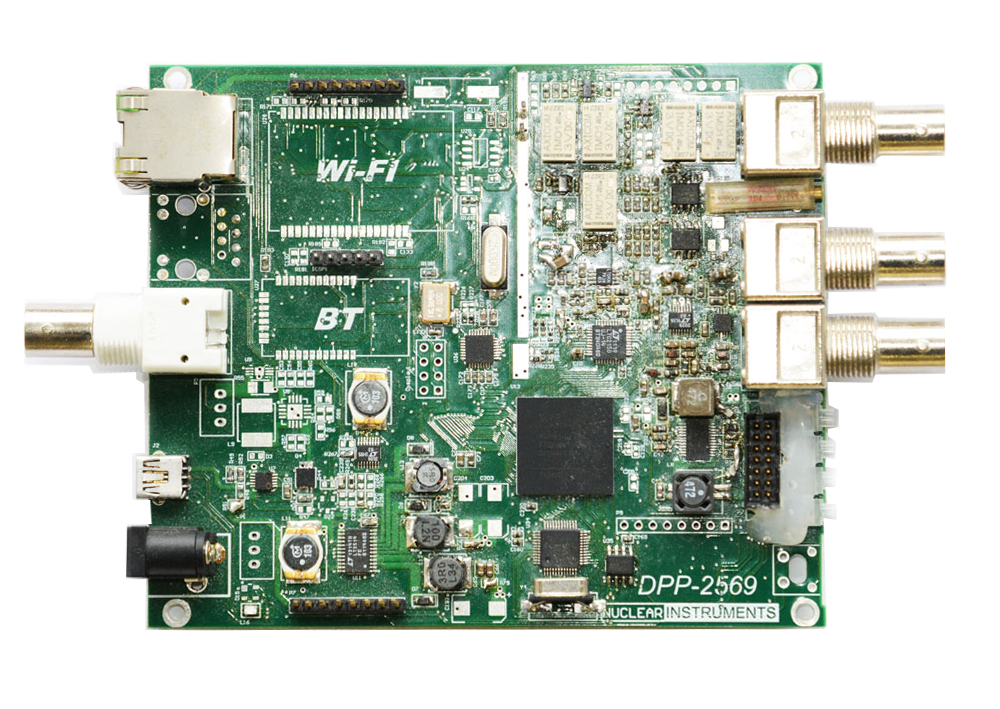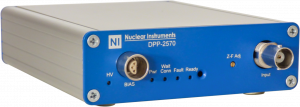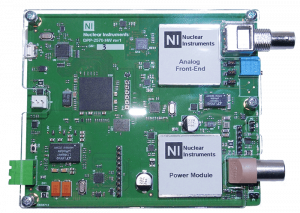Description
Nuclear Instruments offers to systems integrator a Digital Pulse Processor and 16k-Multichannel Analyzer ready to use for OEM applications.
The DPP-2569 Digital Pulse Processor can be used in applications for energy measurements that range from X to Gamma ray spectroscopy for different types of detectors and preamps with continuous and pulsed reset. Main features of the instrument are the extreme compactness and the portability that make it suited for both laboratory and open-air applications. The system could be powered by AC wall adapter, USB, Power over Ethernet, Lithium-ion battery, solar panels. It can be directly interfaced with PC, with USB, Ethernet and WiFi connection. The instrument can be customized and engineered to be fully integrated in the customer systems.
FEATURES
- Analog Input:
- BNC connector
- Single ended, DC/AC coupled
- Both continuous and pulsed reset preamplifiers supported
- Impedance: 50 Ohm / 1 kOhm (sw selectable)
- Positive and negative signals accepted
- Programmable 4-step analog coarse gain corresponding to: 1.25 Vpp, 2.5 Vpp, 5 Vpp, 10 Vpp ranges
- Bandwidth: DC to 30 MHz
- Programmable fine gain: 1..100
- Programmable DC offset adjustment on the input in the full scale range
- Transistor Reset Preamplifier Support
- Selectable gains in the range [2:100] in 12 steps
- AC coupling software selectable (shaper AC ~600ns)
- ADC
- Resolution: 14 bits
- Sampling rate: 150 MS/s
- Digital Signal Processing
- Manual and automated trigger threshold adjustment
- Manual and automated Pole-Zero cancellation; decay time up to 0.65 ms
- Digital decimation in programmable steps: 2-4-8
- Digital fine gain
- Pile-up rejection and Live Time correction
- Baseline restorer with programmable averaging
- Adjustable moving average low pass filter to reduce the high frequency noise
- Preamplifier Power Supply
- DB9 connector
- -± 12 V, 100 mA output (DB9/pin4/pin9)
- -± 24 V, 50 mA output (DB9/pin6/pin7)
- -Output voltage tolerance: 2%
- -Voltage ripple < 5 mVpp
- Operating Modes
- Pulse Height Analysis (PHA): 16k-channel pulse height histogram internally built up; 1k-2k-4k-8k-16k rebin options at software level
- Oscilloscope mode for waveforms monitoring
- Trigger Modes
- Internal trigger
- External: channel is triggered by external trigger only (GP I/O 1 or GP I/O 2)
- Digital I/O
- Two GPIO on LEMO connector with multiplexed function
- Input (Zin 50 Ohm) programmable as: Veto / Gate / Ext. Trigger / Reset
- Output (22 Ohm Terminated) programmable as: Trigger / Energy probe / Pile-up inhibit / Event rejected / Baseline suspended / Acquisition run/stop / SCA (COMING SOON) / Clock
- Communication interface
- Ethernet connection 10/100BT
- Wifi
- USB 2.0 compliant
- MISC
- Firmware can be upgraded via USB/Ethernet
- C/C++ library Windows and Linux
- .NET (VB.NET) open source Software
- Dimensions: 106 W x 38 H x 128 L mm³
- Weight: 300g
FUNCTIONAL DIAGRAM
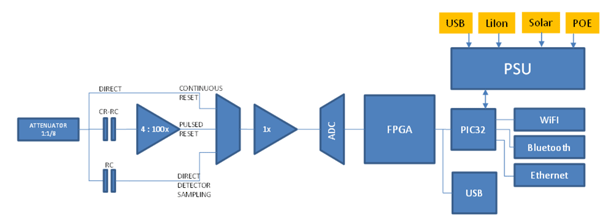
The system architecture is constituted by a shaped analog input, a sampler, a FPGA device and a microcontroller. The input shaping circuit allows to treat the signal coming from different types of detectors and preamps with continuous and pulsed reset, e.g. HPGe and continuous reset preamp, Silicon Drift Detector and pulsed-reset charge preamp. It is also possible to directly connect a detector to the instrument. A programmable gain 0.25 to 100 in 25 steps is also available to best fit the detector output signal to the input instrument dynamic. The shaper output signal is then sampled by a 14 bit ADC operating at 156.25 Msps and then processed by a FPGA device.
FIRMWARE
 The digitized signal is sent to a programmable decimator that enables the instrument to implement filters with a length up to 40 us. The output of the decimation stage is then deconvolved by a three zeros digital deconvolutor circuit. An innovative algorithm automatically calculates the poles of the input signal to find the best zeros position on the z-plane. The deconvolved signal is split and sent to the triggering and processing units. The trigger circuit consists of a fast trapezoidal filter with discrimination. The signal is simultaneously processed by an energy filter with programmable trapezoidal shape that lasts from 40 ns to 40 us. Pileup and saturation circuit are also implemented. The reference level (baseline) of the pulses is estimated and subtracted to the corresponding energy measure. The corrected energy values are collected in a histogram of 16k channels into the FPGA device. The FPGA is connected both to a microcontroller and to a USB interface. The microcontroller is devoted to managing the Ethernet LAN and WiFi.
The digitized signal is sent to a programmable decimator that enables the instrument to implement filters with a length up to 40 us. The output of the decimation stage is then deconvolved by a three zeros digital deconvolutor circuit. An innovative algorithm automatically calculates the poles of the input signal to find the best zeros position on the z-plane. The deconvolved signal is split and sent to the triggering and processing units. The trigger circuit consists of a fast trapezoidal filter with discrimination. The signal is simultaneously processed by an energy filter with programmable trapezoidal shape that lasts from 40 ns to 40 us. Pileup and saturation circuit are also implemented. The reference level (baseline) of the pulses is estimated and subtracted to the corresponding energy measure. The corrected energy values are collected in a histogram of 16k channels into the FPGA device. The FPGA is connected both to a microcontroller and to a USB interface. The microcontroller is devoted to managing the Ethernet LAN and WiFi.
LOW-POWER STAND-ALONE OPERATION MODE
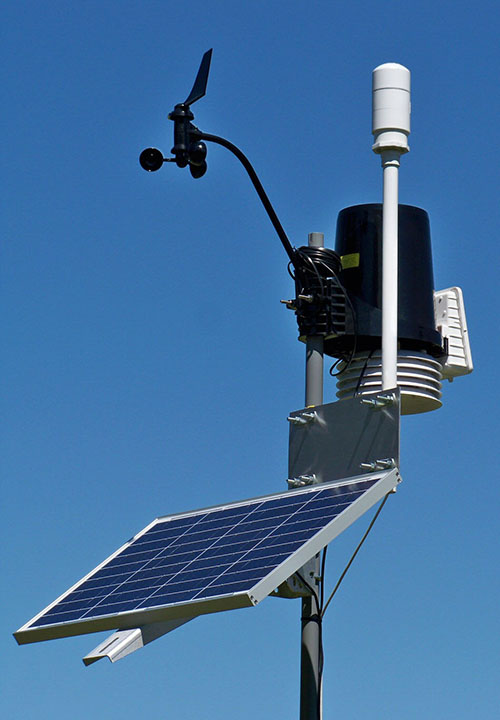 The instrument can operate as a digital acquisition system (DAQ) interfaced in real-time to a host device, e.g. PC or Tablet, or in stand-alone mode. The stand-alone mode allows the system to be idle in standby and make periodic measurements (e.g. of environmental radioactivity) or triggered by an external event. The instrument could be also powered from lithium-ion batteries that can be used as primary power or as backup. In industrial applications (e.g. monitoring of radioactive loads in controlled area) the system can be powered via Power over Ethernet (PoE). The system also integrates the power supply for the preamplifier. In USB-mode it could be self-powered by the host PC.
The instrument can operate as a digital acquisition system (DAQ) interfaced in real-time to a host device, e.g. PC or Tablet, or in stand-alone mode. The stand-alone mode allows the system to be idle in standby and make periodic measurements (e.g. of environmental radioactivity) or triggered by an external event. The instrument could be also powered from lithium-ion batteries that can be used as primary power or as backup. In industrial applications (e.g. monitoring of radioactive loads in controlled area) the system can be powered via Power over Ethernet (PoE). The system also integrates the power supply for the preamplifier. In USB-mode it could be self-powered by the host PC.
PERFORMANCE
The trapezoidal digital filter offer significantly enhanced throughputs and achieve energy resolutions comparable to analog systems. Energy resolution is nearly independent of count rate. Regarding the performance, in one of the experimental test carried out, the DPP has been connected to an HPGe detector with a 60Co source, achieving the resolution 1.8 keV at 10 kCPS (thousand-counts-per-second), whose spectrum is represented below. In another test activity, the instrument has been connected to a silicon drift detector (SDD) with a X-ray source of 55Fe achieving a resolution of 132 eV at 150 kCPS with efficiency of 77% (shaping time equal to 1.8 us), and 200 eV at 700 kCPS with efficiency of 70% (shaping time equal to 0.2 us).


